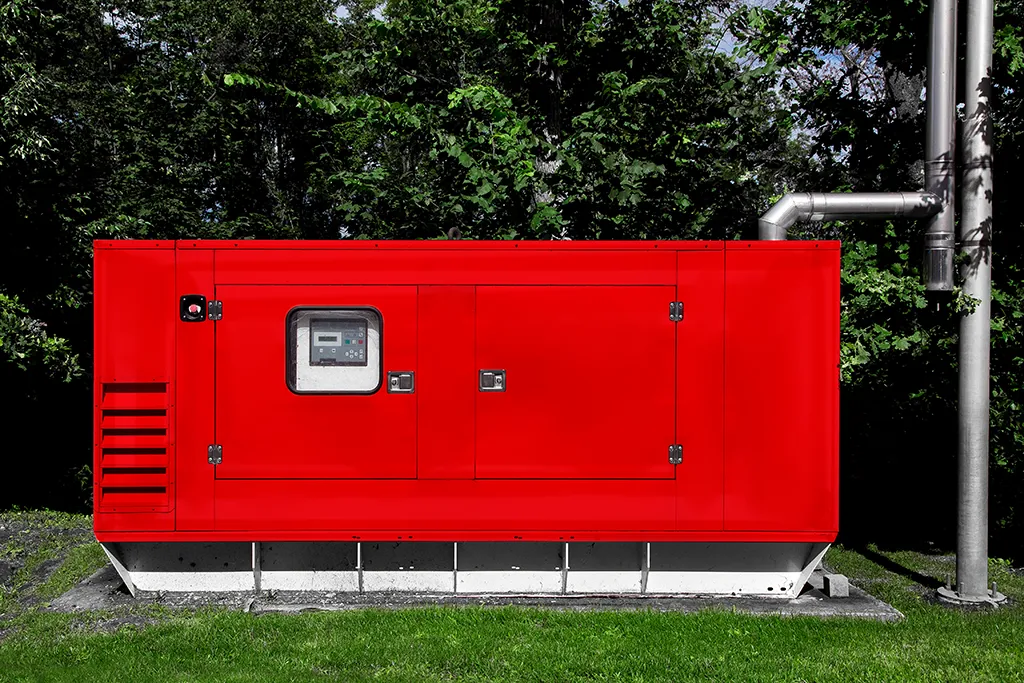Looking for a reliable backup power solution? Let’s dive into a head-to-head comparison of Tesla Powerwall and backup generators. We’ll cover cost, installation, performance, and environmental impact to help you make the best choice.
Key Takeaways
- Tesla Powerwall is a sleek, modern battery backup system that stores energy from solar panels or the grid. It offers seamless, quiet, and eco-friendly power during outages with hardly any maintenance needed.
- Traditional backup generators use fossil fuels to keep your home powered during outages. They require regular maintenance and a steady fuel supply but can keep the lights on for longer periods if you have enough fuel.
- Tesla Powerwall comes with awesome financial perks, like federal and state tax incentives, and helps cut down on electricity bills, making it a budget-friendly and green backup power option.
Getting to Know Powerwall, Solar Panels, and Backup Generators

A reliable backup power source becomes indispensable when the lights go out. Homeowners often weigh two main options: the Tesla Powerwall and traditional gas-powered backup generators. Both serve the same purpose of keeping your home powered during outages, but they operate quite differently and offer distinct benefits.
Tesla Powerwall, a modern backup battery system, captures energy from solar panels or the grid. On the other hand, traditional fuel-powered generators rely on fossil fuels like gasoline, propane, or diesel to keep your home running during a power outage.
What is Tesla Powerwall?
Tesla Powerwall is a game-changing home backup battery that:
- Stores energy from both solar panels and the grid, making sure your home stays powered during an outage
- Can hold up to 13.5 kilowatt-hours of electricity, which can be a lifesaver during a power outage
- Pairing Powerwall with solar panels reduces your dependency on the main power grid and boosts your use of renewable energy
- Even without solar panels, Powerwall can still be a dependable backup power source, drawing and storing energy from the grid.
One of the coolest features of Tesla Powerwall is its ability to automatically switch to stored energy when an outage happens, often without you even realizing the power went out. This means your home stays powered without any interruptions, giving you peace of mind and comfort.
Plus, by using stored electricity from Powerwall and solar panels or the grid, Powerwall helps cut down on the need for fossil fuels, making it a green choice.
What is a Backup Generator?
Backup generators are reliable workhorses that power your home during outages by burning fossil fuels like liquid propane, diesel, or natural gas. These generators are typically installed outdoors and often require additional infrastructure such as a concrete pad and dedicated fuel lines. They are designed to provide power to your home during an outage, ensuring that your essential appliances and systems continue to operate, even when the grid natural gas supply is disrupted.
While traditional generators can be a reliable backup power source, they come with their own set of challenges. To keep them running smoothly, you’ll need to handle regular maintenance, like refueling, servicing, and oil changes. Plus, getting fuel can be tough and pricey during long outages unless your generator is hooked up to a natural gas line. Despite these hurdles, backup generators are still a go-to for many homeowners because they can keep the power on for a long time, as long as you have enough fuel.
Operating and Maintenance Costs
The costs of operating and maintaining your backup power system can vary quite a bit between the Tesla Powerwall and traditional generators. Powerwall, being a modern battery backup, is super low-maintenance, making it a great choice if you want to skip the hassle of regular upkeep. Once it’s set up, it runs quietly and efficiently, needing no fuel and barely any maintenance, which means long-term savings on operating costs. Plus, the virtual power plants warranty adds extra peace of mind for Powerwall owners.
On the flip side, backup generators need regular TLC to keep them running smoothly during an outage. This means refueling, servicing, and oil changes, which can add up over time. Also, fuel prices can be all over the place, impacting the overall cost of running the generator. While generators might seem cheaper upfront, their long-term operating costs can end up being higher compared to the nearly maintenance-free Powerwall.
Installation Requirements and Process
Installing a Tesla Powerwall backup battery is usually a breeze compared to setting up a traditional backup generator. The Powerwall can go both indoors and outdoors and can be mounted on a wall or floor, needing minimal prep. On the flip side, backup generators often need more work, like putting in a concrete pad and hooking up to a fuel line.
These differences in installation can impact the overall cost and complexity of setting up your backup power system.
Installing Tesla Powerwall

Tesla Powerwall is super flexible when it comes to installation. You can put it indoors or outdoors, and it can be mounted on a wall or on the floor. This means you can pick the spot that looks best and works best for you. Plus, the newer Powerwall 3 and Powerwall+ models come with a built-in solar inverter, so you can connect them directly to solar panels for top efficiency.
It’s best to have a Tesla Certified Installer, (like Artisan Electric, wink-wink), handle the installation to make sure everything runs smoothly and safely. The process involves hooking up the Powerwall to a Backup Gateway or Backup Switch, which makes the switch to backup power seamless during an outage. Using a new Backup Switch can also cut down on installation costs since it gets rid of the need for a sub-panel.
Installing a Backup Generator

Installing a backup generator involves a bit more construction work compared to a Powerwall. Generators are usually set up outside and need a concrete slab to keep them steady. Besides the concrete pad, you’ll also need to hook the generator up to a dedicated fuel source, like your home’s natural gas line or a propane tank. This setup is great because it gets rid of the hassle of manual refueling, which is super handy during long outages.
Another key part of installing a generator is the automatic transfer switch. This ensures that the generator can safely and effectively kick in and power your home during an outage. Even though the installation process can be more complicated and pricier, a properly installed generator can provide reliable power for extended periods, making it a common option for many homeowners.
Performance and Reliability During Power Outages
When picking a backup power solution, performance and reliability are super important. Tesla Powerwall really shines here by offering:
- Seamless and uninterrupted power during outages as a backup battery
- Automatic detection of power outages and switching to stored energy in less than one second
- Ensuring that your home stays powered without any noticeable interruption
On the flip side, backup generators usually have a delay of 15-30 seconds before they kick in and start providing power. This difference in response time can be a big deal, especially for critical appliances and systems.
Duration of Power Supply
Considering the duration of power supply during an outage is really important. Tesla Powerwall’s 13.5 kilowatt-hour capacity means it can keep essential appliances and systems running for several hours, depending on your home’s energy needs. For instance, a single Powerwall could power a 100-watt light bulb for 135 hours or a fridge for about a day. The actual time will vary based on how much energy your home uses.
Backup generators, on the other hand, can keep going as long as you have fuel. A well-maintained generator can run for up to three weeks, making it a solid choice for long outages. The only catch is making sure you have enough fuel, which can be tricky to find during widespread outages when fuel supplies might be low.
Consistency and Reliability
Tesla Powerwall is built to keep your home powered consistently and reliably, no matter the weather – from freezing cold to scorching heat. It automatically kicks in during an outage in less than a second, so you won’t even notice the lights flicker, giving you peace of mind and security.
On the other hand, backup generators can struggle to perform consistently, especially in extreme weather. Some of the issues you might face include:
- Keeping up with regular maintenance and servicing
- Managing fuel supplies during long outages
- Making sure the generator is the right size for your home’s needs
These challenges can affect how reliable and effective your generator is. It’s crucial to have a plan to tackle these issues and ensure your generator runs smoothly when you need it most.
Environmental Impact

When it comes to the environment, Tesla Powerwall is a clear winner compared to traditional generators. Powerwall taps into clean, renewable energy sources like solar power, which means it produces zero greenhouse gas emissions while it’s running.
So, if you’re looking to cut down on your carbon footprint, Powerwall is the way to go. It’s an eco-friendly option that helps you live a greener lifestyle without sacrificing power when you need it most.
Carbon Footprint
Tesla Powerwall helps shrink your carbon footprint by using renewable energy to store power. When you pair it with solar panels, Powerwall can stash away extra solar energy during the day and use it to keep your home running at night or during an outage. This means you don’t have to rely so much on fossil fuels, which is great for fighting climate change and making your home more energy-efficient and sustainable.
Traditional gas-powered generators run on fossil fuels like gasoline, propane, or diesel, which pump out carbon emissions and contribute to air pollution. These emissions can really add up, especially if you use the generator a lot. By choosing a Tesla Powerwall, you’re doing your part to keep the environment cleaner and reduce your home’s overall carbon footprint.
Noise and Pollution
Tesla Powerwall operates very quietly, making sure your home stays peaceful without the annoying noise of traditional generators. With an operating noise level of less than 40 dBA, Powerwall is almost silent, which is perfect for neighborhoods where noise can be a big deal. In comparison, backup generators can be as loud as 77 dBA, which can really disturb your household and your neighbors.
Plus, traditional generators aren’t great for the environment since they run on fossil fuels and emit harmful pollutants like carbon monoxide. These emissions can be bad for both your health and the planet. By going with a Tesla Powerwall, you dodge these issues and get a cleaner, quieter backup power solution.
Tax Incentives and Financial Benefits
Your decision-making process can be heavily swayed by financial perks and tax breaks. Tesla Powerwall has some awesome financial advantages, including federal and state tax incentives that can cut down the overall cost of installation. These perks make Powerwall a budget-friendly alternative to traditional generators.
Tax Credits for Tesla Powerwall
Tesla Powerwall qualifies for the Inflation Reduction Act benefit, which allows you to deduct 30% of the cost of a standalone Powerwall system from your federal taxes from 2023 through 2032. This significant financial incentive can substantially reduce the upfront cost of installing a Powerwall, making it a more affordable option. Washington state give you a sales tax exemption for solar energy systems, like rooftop solar panels. The exemption is available through 2029 and can exempt sales taxes for the purchase of machinery, equipment, and installation of solar energy systems.
Powerwall can also help reduce monthly electricity bills by:
- Storing excess solar energy and using it during peak hours or outages
- Providing smart charging and discharging capability
- Giving you maximum economic value from your home energy system through electricity bill grid services
- Leading to long-term savings on your electric bills.
Financial Benefits of Backup Generators
Backup generators generally do not qualify for tax incentives like Tesla Powerwall.
Backup generators can be a pretty cost-effective option over time because they keep the power on during outages. This can save you from losing money on things like spoiled food, missed work, or damage to home systems. For folks who deal with frequent and long power outages, the long-term savings and reliability of a backup generator can be a game-changer.
Choosing the Right Solution for Your Home

Choosing the right backup power solution for your home depends on various factors like your energy needs, budget, and long-term goals. Tesla Powerwall is an eco-friendly and low-maintenance option, while traditional backup generators are reliable for longer periods, especially if fuel supply isn’t an issue.
Understanding these factors can help you make a smart choice that suits your home’s needs and future energy plans.
Assessing Energy Needs
The first step in picking the right backup power solution is to figure out how much energy your home really needs. If your home deals with frequent but short outages, a Tesla Powerwall backup battery might do the trick. Powerwall can store energy from solar panels and the grid, making sure you have a reliable backup power source when the lights go out. For bigger homes with more energy demands, you might need a few Powerwalls to keep everything running smoothly.
But if you live somewhere with long-lasting outages, a bigger backup generator might be more your style. Generators can keep going as long as there’s fuel, making them perfect for those extended blackouts. Knowing your home’s specific energy needs and how often you face outages can help you choose the best option.
Thinking About Future Energy Goals
When picking a home power solution, it’s important to think about your long-term energy goals. If you’re all about sustainability and cutting down on your carbon footprint, the Tesla Powerwall backup battery is a no-brainer. By storing solar energy and relying less on fossil fuels, Powerwall fits right in with long-term sustainability goals. Plus, Powerwall can join virtual power plants, where homes with solar and battery systems work together as one big power plant, boosting grid independence.
And don’t forget, Powerwall’s Time-Based Control feature helps you save on your energy bill by charging when utility rates are low and using stored power when rates are high. This smart energy management not only saves you money but also supports your goals of energy efficiency and sustainability. Thinking about these future energy goals can help you decide whether a Powerwall or a traditional generator is the best fit for your home.
Summary
In a nutshell, both Tesla Powerwall and traditional backup generators have their own perks as backup power solutions. Powerwall is a cutting-edge home battery system that provides seamless backup power, reduces your carbon footprint, and offers great financial incentives. It’s perfect for homeowners looking for a green, low-maintenance solution that works well with solar panels.
Traditional backup generators are great for providing reliable power during long outages, making them ideal for areas that deal with extended blackouts. But they come with higher maintenance and fuel costs, along with some environmental downsides. Ultimately, the best choice depends on your specific energy needs, budget, and long-term goals. By keeping these factors in mind, you can pick the backup power solution that best fits your home and lifestyle.
Frequently Asked Questions
What are the main differences between Tesla Powerwall and traditional backup generators?
The main differences between Tesla Powerwall and traditional backup generators come down to how they operate and what they need to keep running. Powerwall is like a big rechargeable battery for your home, storing energy from solar panels or the grid. It’s smooth, quiet, and pretty much maintenance-free, plus it’s great for the environment. On the flip side, traditional generators burn fossil fuels like propane, diesel, or natural gas, which means they need regular upkeep and a steady fuel supply to keep going.
How much power can a Tesla Powerwall store?
A Tesla Powerwall can store up to 13.5 kilowatt-hours of power, which could power a 100-watt light bulb for 135 hours or a refrigerator for about a day, depending on your home’s energy consumption.
What are the installation requirements for Tesla Powerwall and backup generators?
Installing a Tesla Powerwall is pretty straightforward. You just need to mount it on a wall or the floor, indoors or outdoors. Backup generators, on the other hand, need a bit more work. You’ll need a concrete pad, a dedicated fuel line, and a transfer switch. So, if you want an easier setup, Powerwall is the way to go!
Are there any tax incentives for installing a Tesla Powerwall?
Absolutely! Installing a Tesla Powerwall can get you some sweet tax breaks. You can qualify for the federal Investment Tax Credit (ITC), which lets you deduct 30% of the cost from your federal taxes. Plus, there are state-specific perks like Washington’s sales tax exemption.
How does the environmental impact of Tesla Powerwall compare to that of traditional generators?
Tesla Powerwall is significantly more eco-friendly compared to traditional generators. It operates very quietly and doesn’t produce any greenhouse gases since it uses renewable energy like solar power. Traditional generators, on the other hand, pump out carbon emissions and are pretty noisy since they burn fossil fuels.

